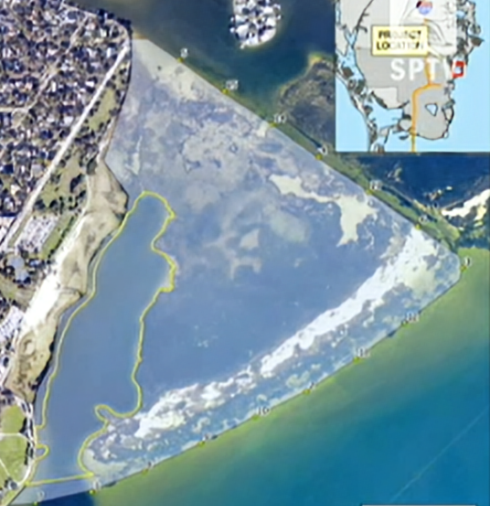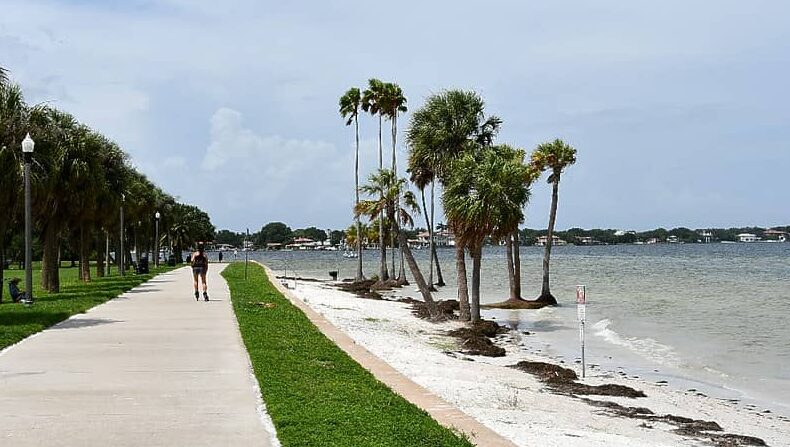Thrive
St. Pete banks on seagrass preservation generating $10 million

Decade-long plans to create an environmentally responsible and financially lucrative seagrass conservation area along St. Petersburg’s downtown waterfront are now taking root.
The much-anticipated, 179-acre Seagrass Mitigation Bank project will protect a critical marine habitat while generating millions of dollars in development credits. City Council members lauded the innovative initiative’s progress and approved a $178,250 supplemental appropriation at their March 27 meeting.
The mitigation bank site, just off the coast of North Shore Park, includes a 147-acre seagrass meadow and a 32-acre dredge hole (an underwater pit from which sediment has been removed for other purposes). Councilmember Mike Harting noted that the project extends well beyond the scope of typical city functions.
“You have invented something – you have designed something that hasn’t been done in the United States,” Harting said. “This is innovative at a different level.”

The dredge hole (yellow outline) and surrounding seagrass meadow site. Screengrab.
In 2015, city officials began developing restoration plans for the massive, decades-old dredge hole used to support downtown development. They need 470,000 cubic yards of the same material removed to fill a pit that engineering and capital improvements director Brejesh Prayman has called “extensively deep.”
A 2021 University of Florida Coastal Policy Lab report stated that “mitigation banking for marine resources is a relatively novel application … typically limited to ports and local governments mitigating impacts of their own activities over time.” The study listed three examples: The Port of Los Angeles, Sarasota County and the City of St. Petersburg.
However, Harting noted that St. Petersburg is not offsetting any internal marine impacts. “You all said, ‘The heck with that. We’re not going to build anything – we’re just going to save stuff.’ You literally invented the whole idea of a true bank.”
The city will accrue at least 13.41 preservation credits sellable to other governments and developers who damage or remove seagrass. Officials previously pegged the per-credit value at $750,000, which would net the city $10.06 million.
Prayman said the city could sell credit fractions at different prices and generate more revenue. “Essentially, we’re the only bank in town.”
Assistant City Attorney Michael Dema said St. Petersburg’s service area extends from Anclote Key south to Sarasota Bay and encompasses the Tampa Bay estuary. He explained that anyone within the “broad geographic scope” must “come to us, the only bank in town,” to purchase credits and offset developmental impacts.
The engineering department needs tons of natural material to fill the dredge hole and support the surrounding habitat’s growth. Meanwhile, just across the Skyway Bridge, the Manatee County Port Authority will extend a docking facility by 600 feet and deepen the adjacent channels.
City officials realized the project would generate enough material to satisfy St. Petersburg’s need “in one event.” Prayman called it serendipity in March 2023; the council approved a mutually beneficial interlocal agreement.
Those plans encountered bureaucratic delays. Prayman said Thursday that an “amazing” interdepartmental team has moved mountains to “get us to the point where we are with this project.”

North Shore Park bifurcates the Gizella Kopsick Palm Arboretum and Vinoy Park. Photo: City of St. Petersburg.
Various regulatory agencies that oversee Tampa Bay restricted the city from regulating access through the site. Officials will install up to 15 warning boaters that they have entered a shallow seagrass area.
With the council’s approval, the city will spend up to $667,000 to fill its dredge hole. Seagrass planting in 2026 and 2027 will cost approximately $1.1 million.
Prayman said officials must monitor the mitigation bank’s success and will receive credits for reaching incremental milestones. Public education regarding construction and the seagrass meadow’s benefits, including signage at North Shore Park, is a critical project component.
Councilmember Brandi Gabbard thanked Prayman for including those aspects. She also noted the challenges associated with receiving state and federal permits to complete work in the bay.
“You guys have never given up,” Gabbard said. “You’ve continued to work; you’ve continued to struggle. But this project is such a winner.”
Prayman said he would submit permits to the U.S. Army Corps of Engineers within two weeks, which then has a 45-day consultation period with other regulatory agencies. The city should begin installing signs and conducting public outreach by “early fall.”
The project team includes the Tampa Bay Watch, a local marine preservation nonprofit. Prayman said permitting regulations may require the city to employ a full-time manatee spotter, and Dema has already volunteered to pull double duty.
Councilmember Lisset Hanewicz said stakeholders should consider documenting their innovative efforts. “This is fantastic work, and I hope I can see a video in the future.”








Lonnie Stoudt
April 5, 2025at12:28 pm
It seems pretty obvious that the real focus here is not preservation of the seagrasses at all, but rather, scamming the incentives system before such neccessary incentive programs are destroyed (moderated).
Hugh Hazeltine
April 2, 2025at9:57 pm
There is a lot to unpack here. Dredging has given positive results for St. Petersburg. Bayboro Harbor was dredged and that provided the fill for Albert Whitted Airport. The three boat basins dredged gave us North and south Straub Park. Beach Drive used to be on the beach. The dredged area in this article gave us North Shore Park.
Now the city will spend $1.7M to potentially get some credits they could sell. We have a new Federal Administration that would like to do away with such credits. Is this effort worth it if we do not get the credits?
Warning signs are a great idea. But maintaining signs in the water is a challenge for the city. There are supposed to be five buoys that mark the swimming area of North Shore Park, currently there are two. The channel leading into Coffee Pot Bayou is missing a green and red marker.
We do not do a good job of protecting the sea grass that is already there. When viewed from above the grass beds are riddled with prop scars.
Does this have any consequences for the Saint Anthony Triathlon? They use this area for the swim and prefer to be in water where the swimmers cannot stand on the bottom.